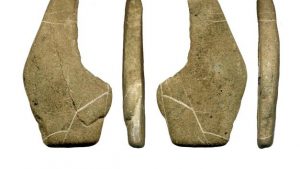A Palaeolithic artefact, described as a “Venus figurine”, was discovered by archaeologists within the Obłazowa Cave, in Nowa Biała, South Poland. It is believed to be 15000 years old.

The discovery was made last during excavations in the cave by a team of archaeologists led by Paweł Valde-Nowak of the Institute of Archaeology at Jagiellonian University in Kraków. The artefact measures 5.5 centimetres in height and is made of a flat sandstone, possibly a pebble found in a river. The researcher describes the shape as a female figurine pictured from the side, with distinct depiction of the buttocks and hips. It is not known whether this type of depictions relates to the sphere of belief of the Prehistoric people, or depicts a real person, possibly a loved one. So far figurines of this type and shape have been found only in two places in Poland – in Wilczyce and Dzierżysław, but over 50 are known from the whole Europe.
Obłazowa cave is known for the remains associated with the Neanderthals, who are believe to be the first occupants of the site, around 100000 years ago. The oldest remains of the Homo sapiens species from the area of Poland were also found in the cave, dating back 30000 years. The figurine dates back to 15000 years ago, a period from which other artefacts have been found, including stone tools used for skinning. Other tools were made of reindeer antlers. According to the researchers the finds suggest that the cave was used on a daily basis and as a permanent settlement.
(after Nauka w Polsce, O2 & Instytut Archeologii Uniwersytetu Jagiellońskiego)
Permalink //
It would be interesting to know at what level in the cave this symbolic figure came from and were any other artefacts found at the same level as the figurine.
The symbolic figurines from Poland might not actually be attributed to the LUP at all, but maybe much older than the current thinking.
I am inclined to believe that they are more likely to be from the EUP transitional L-R-J period, I have many examples of these limestone and sandstone symbolic figurines from the UK. I also have in my collection identical Wilczyce flint examples.
When one considers L-R-J is found in Poland and Britain, I believe there is likely to be a link, perhaps hunting expeditions extending from what is now Britain to Poland and back again.
The evidence suggests that symbolic behaviour began in the Mousterian period and was at it’s height of usage in the L-R-J period. The practice then was absorbed by the incoming AMH, perhaps with some liminality in the Aurignacian period.